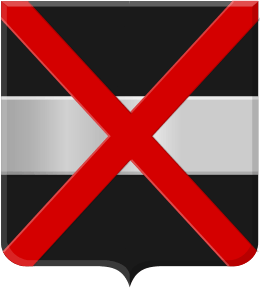Lordship of Baarsdorp
The Lordship of Sinoutskerke and Baarsdorp is a (former) Dutch Lordship situated in the province of Zeeland, in the Netherlands.

Short history
The lordship of Sinoutskerke and Baarsdorp, is a Dutch landed estate. Until 1795 a Dutch lordship (Heerlijkheid) was the Dutch version of manorialism, nowadays it's an estate in land with a set of remaining manorial rights.[1]
The lordship of Baarsdorp was founded between 1206 and 1270, the first lords were Lord Petrus de Barsdorpe and his brother, Lord Dankert de Barsdorpe. The de Barsdorpe brothers were members of the Dutch noble family van Borssele, who named themselves after the lordship.[2] The brothers built a caste and a church, which gave the lordship and village of Baarsdorp a more prestigious aura.[3] The lordship of Baarsdorp remained in this family for the next 200 years, until in the fifteenth century the noble family van de Waerde became the owners. From then on the lordships of Baarsdorp and Sinoutskerkeformally merged.[4] A hundred years later the castle was demolished after it was left empty for two decades. In 1846 the lordship of Sinoutskerke and Baarsdorp was owned by 7 people.[5]
Up until today the manorial rights are still being exerted by the van Huykelom van de Pas family, who are the current owners of the lordship. Sinoutskerke and Baarsdorp is one of the very few remaining lordships in the Netherlands with living rights attached to it. Among those rights are fishing rights, sheep drifting and rights to plant trees etc. on the sides of the roads.[6]
Coat of arms
The coat of arms of the lordship of Sinoutskerke and Baarsdorp is mentioned in 1696 in Mattheus Smallegange's “Cronyk van Zeeland” (Chronicle of Zeeland). According to Smallegange, the coat of arms of the lordship of Baarsdorp initially were the coat of arms of a branch of the van Borssele family, and adopted by the lordship after this family died out.[7] Similar coat of arms were later also used by the municipality of Sinoutskerke and Baarsdorp, with permission of the Dutch High Council of Nobility.[8]
References
- F.C.J. Ketelaar, "Oude zakelijke rechten, vroeger, nu en in de toekomst", Universitaire Pers Leiden, Tjeenk Willink 1978
- P.A. Harthoorn, “Baarsdorp, schets van opkomst, bloei en verval van een Zuid-Bevelands dorp", Tijdschrift Nehalennia, no. 86, Middelburg 1990, p. 21-28
- A.J. van der Aa, Aardrijkskundig woordenboek der Nederlanden 2. Gorinchem, 1845, p. 24
- P.A. Harthoorn, “Baarsdorp: Heerlijkheid, Poeldorp, Monument”. Goes, 1986, p. 33-38
- C.E.G. Ten Houte de Lange, “Heerlijkheden in Nederland”. Hilversum 2008, p. 65 and p. 107
- Stichting Familie van Huykelom van de Pas. "Heerlijkheid Sinoutskerke en Baarsdorp". baarsdorp-sinoutskerke.nl. Retrieved 2018-02-09.
- M. Smallegange, “Nieuwe Cronyk van Zeeland”. Middelburg 1696, p. 399-401
- "Hoge Raad van Adel". Therightproductions.nl. Retrieved 2018-02-09.